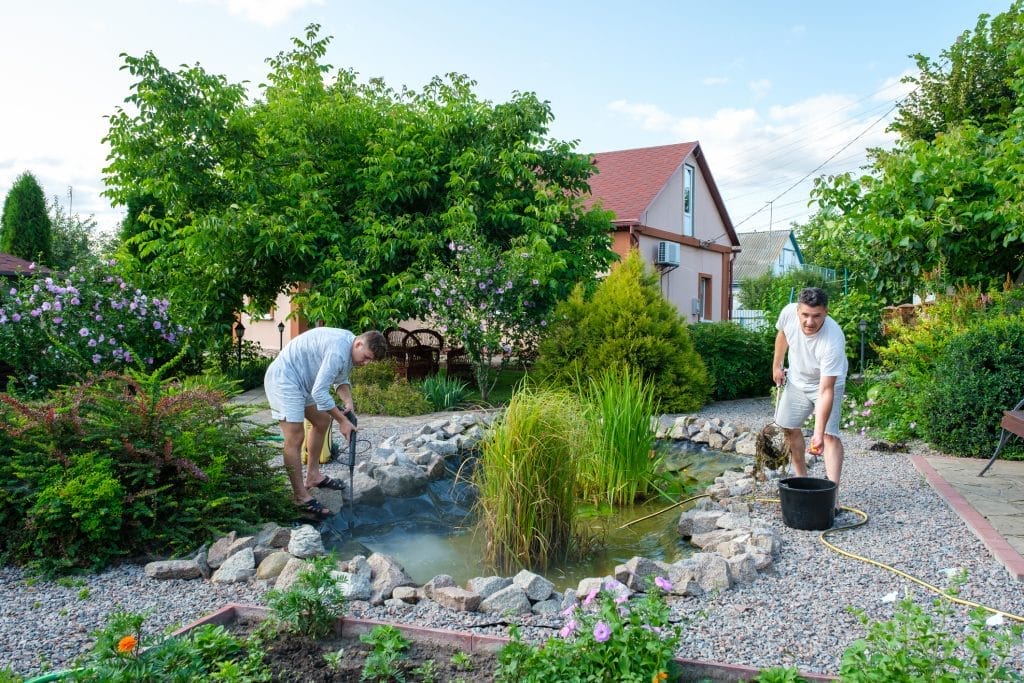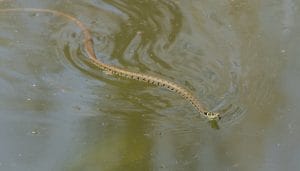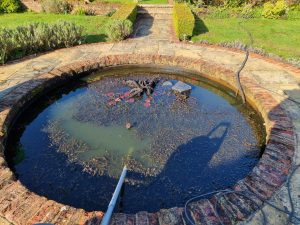
Pricing for Pond Cleaning: Understanding Costs and Services
Pond cleaning is essential for maintaining a healthy aquatic environment.
The average cost for pond cleaning ranges from £350 to £600, with typical prices around £450.
Factors such as pond size, the time since the last cleaning, and the specific services needed can all influence the final price.

Understanding these costs can help pond owners budget effectively and ensure their ponds remain vibrant and attractive.
Regular maintenance not only enhances the appearance of a pond but also contributes significantly to the ecosystem, making it crucial for water quality and wildlife health.
Choosing the right professionals for pond cleaning is also key to achieving the best results.
Equipped with knowledge about pricing structures and potential additional services, pond owners can make informed decisions that will benefit their ponds in the long run.
Key Takeaways
- Pond cleaning costs typically range from £350 to £600.
- Regular maintenance is vital for ensuring a healthy pond environment.
- Selecting experienced professionals can enhance the effectiveness of pond upkeep.
Understanding Pond Cleaning
Effective pond cleaning is essential for maintaining a healthy aquatic environment.
Regular maintenance not only keeps the pond looking good but also supports the diverse life within it.
Proper cleaning methods can enhance water quality and prevent issues like algae overgrowth.
Essential Pond Maintenance
Essential pond maintenance includes several key tasks that help keep the water clean and clear.
Regularly removing debris such as leaves and twigs is important.
Accumulated organic matter can lead to decreased water quality and encourage unwanted algae growth.
Cleaning the pond’s filters and pumps is another crucial step.
Clogged filters can hinder water circulation, affecting oxygen levels for fish and plants.
Professional pond cleaning services usually range from £350 to £600, depending on the size and condition of the pond.
Moreover, maintaining water levels and checking for leaks can prevent larger problems.
Fish feeding and plant care also contribute to overall pond health.
Establishing a routine can lead to a more stable and enjoyable aquatic environment.
Impact on the Pond Ecosystem
Maintaining a healthy pond ecosystem requires careful attention to water quality and the organisms that inhabit it.
Clean water supports fish, plants, and beneficial microorganisms, which all play a role in achieving balance.
Regular cleaning helps control algae, which can choke out other aquatic plants and disrupt the habitat for fish.
Properly managed ponds will see a diverse array of species, enhancing the ecosystem’s resilience.
It’s also important to monitor factors like pH and nutrient levels, as these can greatly impact fish health and plant growth.
A well-maintained pond encourages biodiversity, making it a more vibrant ecosystem.
Ensuring that both plants and animals have the right conditions is fundamental to sustaining pond life.
Types of Ponds
Different types of ponds serve various purposes and have unique maintenance needs. Understanding these differences helps in managing cleaning and upkeep effectively.
Koi Ponds and Maintenance
Koi ponds are designed specifically for keeping koi fish.
They require deeper water than typical backyard ponds, often exceeding 1.5 meters. This depth helps maintain a stable temperature and provides space for koi to thrive.
Maintenance includes regular cleaning to prevent algae growth and ensure water quality.
Common tasks involve removing debris, vacuuming the pond floor, and checking filtration systems.
Costs can be higher due to the extra care needed for koi, with professional cleanings averaging around £450.
It’s essential to monitor water parameters, as koi are sensitive to changes.
Regular additions of beneficial bacteria can help maintain a healthy ecosystem within the pond.
Garden Ponds and Their Unique Needs
Garden ponds serve as tranquil additions to landscapes, offering aesthetic beauty and attracting wildlife.
These ponds can vary in size and depth, depending on the desired ecosystem.
Typical maintenance includes managing plant life, removing leaves, and ensuring clear water.
Garden ponds benefit from filtering systems and may require treatments to control algae and maintain water quality.
Annual cleaning costs for garden ponds generally range from £350 to £600, depending on size and specific needs.
Water gardens within garden ponds often feature lilies and other aquatic plants.
These plants not only enhance beauty but also support the ecosystem by providing oxygen and shade for fish and other wildlife.
Regular observation is key to maintaining balance in a garden pond’s environment.
Factors Affecting Pond Cleaning Costs

When determining the cost of pond cleaning, several specific factors come into play.
The size and overall condition of the pond significantly influence the pricing, as do the management of any aquatic plants present.
Pond Size and Condition
The size of the pond is one of the most crucial determinants of cleaning costs.
Generally, larger ponds require more time and resources to clean.
For instance, a small pond may cost around £350 to £450 for cleaning, whereas a larger one can reach upwards of £800 or more, depending on other conditions.
Condition also plays a major role.
Ponds with excessive debris, muck, or sediment buildup will demand more intensive cleaning efforts.
This may involve the removal of sludge and may require specialised equipment.
As a brief guide:
- Small Pond (under 500 sq ft): £350 – £450
- Medium Pond (500 – 1,000 sq ft): £450 – £600
- Large Pond (over 1,000 sq ft): £600 – £800+
These estimates reflect standard cleaning services, and additional charges may apply for unique circumstances.
Aquatic Plant Management
Aquatic plants can enhance the beauty of a pond but also complicate cleaning tasks.
The presence of invasive or overgrown plants can add to the difficulty, thus increasing costs.
Hiring professionals often helps manage these plants effectively, as they can require specialised techniques and tools.
Costs for plant management can vary widely, from £125 to £350 or more, based on the extent of the work needed.
Key considerations include:
- Invasive plant removal: More costly due to the need for specific methods.
- Regular maintenance: This can prevent significant plant overgrowth, saving money in the long run.
- Plant health: Healthy plants may not require as much work, thereby reducing costs.
Regular attention to aquatic plants is essential for maintaining the pond’s ecosystem and keeping cleaning costs manageable.
Pricing Structure for Pond Cleaning Services

Understanding the pricing structure for pond cleaning services is essential for pond owners. This section will explore the differences between one-time cleanings and regular maintenance, as well as the costs associated with DIY pond maintenance.
One-Time Cleaning Vs Regular Maintenance
One-time pond cleaning services typically have a higher upfront cost. These services focus on deep cleaning the pond and restoring its condition.
The average cost for a full service can range from £350 to £600, depending on the pond’s size and condition. Most companies charge around £165 per hour for their services.
In contrast, regular maintenance is usually more cost-efficient in the long run.
This involves scheduled visits to monitor and care for the pond.
The cost for regular maintenance might be around £129 per hour for professionals, which helps spread out costs and ensures the pond remains in good health year-round.
By scheduling regular cleanings, pond owners may save money by avoiding extensive cleanouts in the future.
Cost of DIY Pond Maintenance
DIY pond maintenance can seem appealing due to lower costs. However, it can still incur expenses for necessary equipment, supplies, and chemicals.
Basic tools such as nets, pumps, and filters may cost around £100 to £300 upfront.
Additionally, pond owners must consider the time investment required.
Maintenance tasks include removing debris, managing algae, and checking water quality.
This commitment can take several hours each month.
Failure to keep up with regular maintenance can lead to more significant problems that require professional services, adding unexpected costs later on.
Thus, while DIY may offer short-term savings, the long-term financial implications should be carefully weighed.
Koi Pond Maintenance Considerations

Maintaining a koi pond requires specialised care and attention to detail. Understanding the associated costs is also vital for proper budgeting and maintenance planning.
Specialised Care for Koi Ponds
Koi ponds need specific care to keep the fish healthy and the environment balanced.
Regular monitoring of water quality is essential. Key factors include pH levels, ammonia, and nitrite concentrations.
Proper filtration systems are crucial. They help remove debris and harmful substances from the water.
Additionally, a well-maintained pump system ensures proper circulation, which is vital for fish health.
Feeding practices should also be considered.
Koi require a balanced diet to thrive. This includes high-quality pellets and occasional treats like vegetables. Seasonal changes may affect feeding frequency and quantity.
Regular cleaning is necessary.
This includes removing fallen leaves and algae. Cleaning tools such as nets and vacuums may help maintain water clarity.
Koi Pond Maintenance Costs
Understanding koi pond maintenance costs is vital for owners. The average cleaning price ranges between £300 and £3,000, depending on pond size and maintenance needs.
Yearly maintenance can cost between £600 and £2,900.
Regular checks will help catch any issues early, saving money in the long run.
Additional expenses may include specialised care. For instance, hiring professionals may lead to higher costs, but they ensure the pond’s health and balance.
Investments in equipment like filters or pumps can also add to the budget.
Long-term care will require a proper financial plan to ensure the pond remains healthy and visually appealing.
Additional Maintenance Services
Proper pond care often extends beyond cleaning. Additional maintenance services ensure that the ecosystem remains healthy and functional.
These services include pump repairs and water treatments, which are essential for maintaining a balanced environment.
Pump Repairs and Water Treatments
Pumps play a crucial role in maintaining water circulation and quality.
A malfunctioning pump can lead to stagnant water, which may harm fish and plants.
Regular inspection and prompt repairs are vital to prevent such issues.
Water treatments are equally important. They help manage algae growth, remove harmful chemicals, and promote a balanced pH level.
Using quality products tailored for the pond’s specific needs can lead to a healthier environment.
Cleaning filters and ensuring the pump operates efficiently also contribute significantly to water clarity and quality.
Employing Detoxifiers for Healthy Habitats
Detoxifiers are essential for maintaining a safe and thriving pond.
These products help break down harmful substances that might accumulate in the water.
For instance, when organic material decays, it can release toxins. Detoxifiers target these harmful elements, reducing their impact on aquatic life.
It is crucial to choose detoxifiers suitable for specific pond conditions.
By using these treatments regularly, pond owners can minimise risks and enhance overall water quality. This not only benefits fish and plants but also ensures a sustainable ecosystem for years to come.
Maintaining Water Quality
Maintaining water quality is essential for the health of a pond. Good water quality prevents harmful algae growth and protects fish and plants.
Two key factors in keeping water quality high are effective filtration systems and controlling toxic gases.
Filtration Systems
A robust filtration system is crucial for maintaining clean water in a pond. It helps remove debris, excess nutrients, and harmful bacteria.
Common types of filters include mechanical, biological, and chemical filters.
Mechanical filters physically remove particles from the water. They are essential for keeping the water clear.
Biological filters support beneficial bacteria that break down waste. This process converts harmful substances into less toxic forms.
Chemical filters can remove specific contaminants, such as chlorine and heavy metals.
Regular maintenance of the filtration system is critical.
This includes cleaning or replacing filter media and checking for proper flow rates.
Neglecting these tasks can lead to poor water quality and negatively affect pond life. A properly functioning system reduces the need for frequent cleaning.
Controlling Toxic Gases
Toxic gases such as ammonia and hydrogen sulphide can harm aquatic life. These gases often build up in stagnant water where decaying organic matter is present.
Regular aeration helps prevent these gases from accumulating.
Using aerators or fountains can improve water movement and add oxygen. This promotes a healthy environment and reduces the risk of gas buildup.
Additionally, it aids in the breakdown of organic material by beneficial bacteria.
Monitoring water quality is crucial.
Testing kits can measure levels of ammonia, nitrites, and nitrates.
If levels rise too high, immediate action must be taken. This may involve increasing aeration or removing excess debris.
Regular monitoring keeps the pond healthy and safe for its inhabitants.
Budgeting for Pond Upkeep
Maintaining a pond requires careful budgeting. Understanding the average costs can help owners manage expenses effectively.
The average annual pond maintenance cost can vary significantly based on size and condition. Typically, costs can range from £100 to £400 for cleaning services.
Basic Costs to Consider:
- Professional Cleaning: £350 to £800
- Filter and Pump Maintenance: £125 to £165
- Fish and Plant Care: £125 to £250
Additional costs might arise for deeper cleanings, especially for koi ponds. They may require more attention and can cost around £400 annually for service.
It is essential to account for unexpected repairs and extra treatments, which can add to the yearly budget.
Regular maintenance helps prevent larger, unplanned expenses.
Pond owners should track their costs throughout the year.
Keeping a simple spreadsheet can assist in monitoring spending and planning for future expenses.
This approach helps ensure that the pond remains a beautiful and healthy feature in the garden, without overspending.
He or she should also consider local services that provide packages for regular maintenance. These can sometimes offer savings when compared to individual services.
Seasonal Pond Maintenance Tips
Regular maintenance is essential for keeping a pond healthy and beautiful. Seasonal tasks help ensure clear water and a vibrant ecosystem. This section covers key practices for spring rejuvenation and winter preparations.
Spring Rejuvenation
As the weather warms up, it’s time to focus on revitalising the pond.
Begin by removing any debris like leaves and twigs that have settled during winter. This prevents sludge build-up and helps improve water clarity. Using a pond net can make this task easier.
Next, conduct a thorough check of the pond’s water quality.
Test for pH levels, ammonia, and nitrate concentrations. This ensures a safe environment for fish and plants.
Cleaning the pond filters and checking the pump system should not be overlooked.
Draw attention to aquatic plants, trimming dead foliage to encourage new growth.
Finally, consider introducing beneficial bacteria to the pond. This will help break down organic matter and maintain a balanced ecosystem.
Winter Preparations
In autumn, preparing the pond for winter is crucial.
First, remove any floating debris and fallen leaves to prevent decay under the ice. This helps maintain water quality during colder months.
Next, ensure that the pond’s pump and filters are functioning well before the first frost.
It’s vital to lower the water levels slightly if the pond has fish. This creates a buffer against freezing temperatures.
Consider installing a pond heater or aerator to keep a small area of water unfrozen. This allows for gas exchange and keeps fish safe.
Finally, check that any plants, especially tender varieties, are protected from the cold. Preparing the pond properly can save considerable work come spring.
Choosing the Right Professionals
When selecting a professional for pond cleaning, experience is crucial. Experienced professionals understand the specific needs of different types of ponds. They can provide tailored services based on the pond’s size and condition.
Potential clients should look for pond cleaning services with strong customer reviews.
Checking ratings and testimonials can reveal valuable insights about their reliability and quality of work.
It’s also important to compare costs.
Professional pond cleaning can range from £350 to £800, depending on various factors like pond size and cleaning requirements.
When interviewing candidates, consider asking about their qualifications and methods.
- What cleaning techniques do you use?
- How do you handle waste disposal?
- Are you licensed and insured?
These queries help ensure that one hires someone knowledgeable and capable.
Additionally, verify if they offer regular maintenance plans.
Regular upkeep can prevent excessive build-up of debris and algae, saving money in the long run.
Finally, ensure that the professionals use environmentally friendly products. This is important for the health of the pond ecosystem.
Best Practices for a Healthy Pond
Maintaining a clean pond is essential for a healthy ecosystem.
Regular cleaning helps to prevent algae build-up and keeps the water clear for aquatic life.
One important practice is to remove debris frequently.
This includes fallen leaves and other organic material that can decompose and affect water quality.
Another key aspect is to monitor water levels.
Consistent water levels help maintain the balance of aquatic life. If levels drop too low, fish and plants can suffer.
Regular testing of the water quality is also vital.
Checking pH, ammonia, and nitrate levels ensures the pond’s environment supports fish and plants properly.
Incorporating aquatic plants helps enhance oxygen levels and provide shelter for fish.
Plants like water lilies and cattails can be beneficial for maintaining balance in the pond.
Setting up a filter system can improve water circulation and clarity.
Filters help remove particles and keep the pond looking clean.
Lastly, ensuring that fish populations are balanced is essential.
Overcrowding can lead to harmful effects on water quality and aquatic life.



